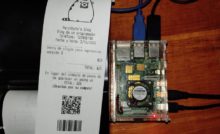Forzar Raspberry Pi para HDMI
En este post te mostraré cómo forzar la salida HDMI en la Raspberry Pi, pues en ocasiones la Pi no envía señal HDMI a la pantalla o monitor, y solo sucede en estos casos. Es decir, te mostraré cómo solucionar el problema de que la Raspberry no envía señal.
A mí me pasó que en mi monitor funcionaba bien, pero en una pantalla de TV que tengo, no. Así que investigando encontré cómo hacer que la Raspberry Pi envíe señal HDMI.
Nota: obviamente esto funcionará si la Pi está funcionando normalmente, es decir, que tenga el sistema instalado y que esté comprobado que funciona y envía señal. Esto más que nada es para cuando el problema es el monitor o pantalla.
Configurando boot/config.txt
Te recomiendo crear un respaldo del archivo antes de modificarlo.
Todo lo que necesitamos configurar está en /boot/config.txt. Puedes usar el editor nano o vim, incluso puedes conectar la SD a Windows y el mismo detectará la partición.
Lo que tenemos que cambiar es lo siguiente, pero además te recomiendo que mires el archivo que dejo más adelante:
hdmi_group=2hdmi_mode=4hdmi_force_hotplug=1
Por cierto, hdmi_safe debe estar comentado. Es decir, tener un # al inicio. Solo como referencia, aquí dejo mi config.txt.
# For more options and information see
# http://rpf.io/configtxt
# Some settings may impact device functionality. See link above for details
# uncomment if you get no picture on HDMI for a default "safe" mode
#hdmi_safe=1
# uncomment this if your display has a black border of unused pixels visible
# and your display can output without overscan
#disable_overscan=1
# uncomment the following to adjust overscan. Use positive numbers if console
# goes off screen, and negative if there is too much border
#overscan_left=16
#overscan_right=16
#overscan_top=16
#overscan_bottom=16
# uncomment to force a console size. By default it will be display's size minus
# overscan.
#framebuffer_width=1280
#framebuffer_height=720
# uncomment if hdmi display is not detected and composite is being output
hdmi_force_hotplug=1
# uncomment to force a specific HDMI mode (this will force VGA)
hdmi_group=2
hdmi_mode=4
# uncomment to force a HDMI mode rather than DVI. This can make audio work in
# DMT (computer monitor) modes
#hdmi_drive=2
# uncomment to increase signal to HDMI, if you have interference, blanking, or
# no display
config_hdmi_boost=4
# uncomment for composite PAL
#sdtv_mode=2
#uncomment to overclock the arm. 700 MHz is the default.
#arm_freq=800
# Uncomment some or all of these to enable the optional hardware interfaces
#dtparam=i2c_arm=on
#dtparam=i2s=on
#dtparam=spi=on
# Uncomment this to enable infrared communication.
#dtoverlay=gpio-ir,gpio_pin=17
#dtoverlay=gpio-ir-tx,gpio_pin=18
# Additional overlays and parameters are documented /boot/overlays/README
# Enable audio (loads snd_bcm2835)
dtparam=audio=on
[pi4]
# Enable DRM VC4 V3D driver on top of the dispmanx display stack
dtoverlay=vc4-fkms-v3d
max_framebuffers=2
[all]
#dtoverlay=vc4-fkms-v3dDe este modo la Raspberry va a funcionar en todas o al menos la mayoría de pantallas, manteniendo la compatibilidad con las que anteriormente ya funcionaba. No olvides reiniciar el sistema.
Con esto me refiero a que en mi caso lo configuré así para que fuera compatible con una TV, pero al conectarla a mi monitor seguía funcionando sin problemas. Lo único que cambió un poco fue la resolución pero eso no fue molesto pues al final la iba a usar para convertirla en consola.
Archivo config.txt original
Por cierto, en caso de que configures algo y después no funcione, te recomiendo conectarte por SSH y restablecer el archivo original. Por si no lo tienes, aquí lo dejo:
# For more options and information see
# http://rpf.io/configtxt
# Some settings may impact device functionality. See link above for details
# uncomment if you get no picture on HDMI for a default "safe" mode
#hdmi_safe=1
# uncomment this if your display has a black border of unused pixels visible
# and your display can output without overscan
#disable_overscan=1
# uncomment the following to adjust overscan. Use positive numbers if console
# goes off screen, and negative if there is too much border
#overscan_left=16
#overscan_right=16
#overscan_top=16
#overscan_bottom=16
# uncomment to force a console size. By default it will be display's size minus
# overscan.
#framebuffer_width=1280
#framebuffer_height=720
# uncomment if hdmi display is not detected and composite is being output
#hdmi_force_hotplug=1
# uncomment to force a specific HDMI mode (this will force VGA)
#hdmi_group=1
#hdmi_mode=1
# uncomment to force a HDMI mode rather than DVI. This can make audio work in
# DMT (computer monitor) modes
#hdmi_drive=2
# uncomment to increase signal to HDMI, if you have interference, blanking, or
# no display
#config_hdmi_boost=4
# uncomment for composite PAL
#sdtv_mode=2
#uncomment to overclock the arm. 700 MHz is the default.
#arm_freq=800
# Uncomment some or all of these to enable the optional hardware interfaces
#dtparam=i2c_arm=on
#dtparam=i2s=on
#dtparam=spi=on
# Uncomment this to enable infrared communication.
#dtoverlay=gpio-ir,gpio_pin=17
#dtoverlay=gpio-ir-tx,gpio_pin=18
# Additional overlays and parameters are documented /boot/overlays/README
# Enable audio (loads snd_bcm2835)
dtparam=audio=on
[pi4]
# Enable DRM VC4 V3D driver on top of the dispmanx display stack
dtoverlay=vc4-fkms-v3d
max_framebuffers=2
[all]
#dtoverlay=vc4-fkms-v3dSolo recuerda que deberías tomarlo para guiarte, pues puede que en tu caso el original sea diferente debido a una actualización o diferencia de software.
Entradas recientes
Cancelar trabajo de impresión con C++
En este post te quiero compartir un código de C++ para listar y cancelar trabajos…
Copiar bytes de Golang a JavaScript con WebAssembly
Gracias a WebAssembly podemos ejecutar código de otros lenguajes de programación desde el navegador web…
Imprimir PDF con Ghostscript en Windows de manera programada
Revisando y buscando maneras de imprimir un PDF desde la línea de comandos me encontré…
Hacer pruebas en impresora térmica Bluetooth Android
Esta semana estuve recreando la API del plugin para impresoras térmicas en Android (HTTP a…
Limpiar clave PEM
Hoy te enseñaré a extraer la cadena base64 de una clave PEM usando una función…
Foco con Telegram, apagador de 3 vías, relevador y ESP8266
Encender un foco con un Bot de Telegram es posible usando una tarjeta como la…



